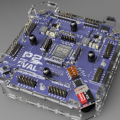Help programming a Pic 12f675
 W9GFO
Posts: 4,010
W9GFO
Posts: 4,010
I'm working on a project where I need the Pic to read a servo pulse and then output a high or low depending on what that pulse value is. I would think that it would be a very simple program.
Last night I dug out my PicKit 1 (never used it) and downloaded the MPlab IDE. I expected that with a few years worth of experience using Basic Stamps and the Propeller chip that I would be able to muddle my way through this Pic thing. Not so.
Then I spend a couple hours searching the interwebs for a good tutorial. I find lots of info but it none of it is what I am looking for. I just need a sample program (in Basic or C) so that I can understand how to put together my own code.
A while back someone offered to help with Pic programming but I can't remember who that was. I really don't want to have to join another forum for something so simple when I know that there are many here that can help. That would be like telling someone to join a semiconductor forum when they have a question about a diode.
I really wish Parallax made a single cog, 8 pin, < 1$ Propeller chip. Then I wouldn't have to turn to MicroChip.
Rich H
▔▔▔▔▔▔▔▔▔▔▔▔▔▔▔▔▔▔▔▔▔▔▔▔
The Simple Servo Tester, a kit from Gadget Gangster.
Last night I dug out my PicKit 1 (never used it) and downloaded the MPlab IDE. I expected that with a few years worth of experience using Basic Stamps and the Propeller chip that I would be able to muddle my way through this Pic thing. Not so.
Then I spend a couple hours searching the interwebs for a good tutorial. I find lots of info but it none of it is what I am looking for. I just need a sample program (in Basic or C) so that I can understand how to put together my own code.
A while back someone offered to help with Pic programming but I can't remember who that was. I really don't want to have to join another forum for something so simple when I know that there are many here that can help. That would be like telling someone to join a semiconductor forum when they have a question about a diode.
I really wish Parallax made a single cog, 8 pin, < 1$ Propeller chip. Then I wouldn't have to turn to MicroChip.
Rich H
▔▔▔▔▔▔▔▔▔▔▔▔▔▔▔▔▔▔▔▔▔▔▔▔
The Simple Servo Tester, a kit from Gadget Gangster.


Comments
▔▔▔▔▔▔▔▔▔▔▔▔▔▔▔▔▔▔▔▔▔▔▔▔
Mike2545
This message sent to you on 100% recycled electrons.
;flasher.asm ;simple program for PIC12F675 to flash LED on pin 5 ;uses Timer0 for delay list p=12f675 ;list directive to define processor #include "p12f675.inc" ;processor specific variable definitions ;----------------------------------------------------------------- ;defines ;----------------------------------------------------------------- #define LED 2 ;GP2 (pin 5) #define INIT_COUNT 10 ; ;----------------------------------------------------------------- ;variables ;----------------------------------------------------------------- cblock 0x20 Shadow tick_counter endc ;------------------------------------------------------------------ ;initialisation ;------------------------------------------------------------------ ;reset vector org 0 goto Main ;interrupt vector org 4 banksel INTCON bcf INTCON,T0IF ;clear Timer0 interrupt flag movlw INIT_COUNT ;re-initialise count movwf TMR0 decf tick_counter,f retfie Main: banksel ANSEL movlw 11h ;AN0 as analog input,conversion clock Fosc/8 movwf ANSEL bankseL CMCON movlw 07h ;comparators off movwf CMCON banksel TRISIO bcf TRISIO,LED ;LED output GPIO5 (pin 2) banksel OPTION_REG movlw b'00000011' ;prescaler 1/128 movwf OPTION_REG ; banksel TMR0 movlw INIT_COUNT ;initialise timer count value clrf tick_counter movwf TMR0 bsf INTCON,GIE ;enable global interrupt bsf INTCON,T0IE ;enable Timer0 interrupt banksel GPIO ;----------------------------------------------------------------------- ;main program loop ;----------------------------------------------------------------------- ;loop: ; bsf Shadow,LED ;LED off ; movfw Shadow ; movwf GPIO ; call dly ; bcf Shadow,LED ;LED off ; movfw Shadow ; movwf GPIO ; call dly ; goto loop loop: bsf GPIO,LED call dly bcf GPIO,LED call dly goto loop dly: movlw 0x10 movwf tick_counter dly1: movf tick_counter,f skpz goto dly1 return endI can let you have the MPLAB project directory, if that helps.
Read-Modify-Write isn't a problem with this program because of the delays, but I've included some commented-out code that uses a shadow register to avoid R-M-W effects.
73, Leon
▔▔▔▔▔▔▔▔▔▔▔▔▔▔▔▔▔▔▔▔▔▔▔▔
Amateur radio callsign: G1HSM
Post Edited (Leon) : 11/22/2009 9:00:37 PM GMT
-Phil
PICBasic looks to be a good fit for me - wish they had a trial version. Would I need to purchase a programmer as well or is there a way I can use MPLab to to get the compiled code into the chip?
Rich H
▔▔▔▔▔▔▔▔▔▔▔▔▔▔▔▔▔▔▔▔▔▔▔▔
The Simple Servo Tester, a kit from Gadget Gangster.
Leon
▔▔▔▔▔▔▔▔▔▔▔▔▔▔▔▔▔▔▔▔▔▔▔▔
Amateur radio callsign: G1HSM
▔▔▔▔▔▔▔▔▔▔▔▔▔▔▔▔▔▔▔▔▔▔▔▔
Mike2545
This message sent to you on 100% recycled electrons.
I have found Proton PicBasic Lite which seems very similar to the MeLabs PicBasic and it does support the 12f675 - the PicBasic Pro demo does not.
I'm geting closer, Proton's PicBasis is supposed to be accessible from within MPlab, I'll see if I can get it to work soon.
I requested some AtTiny 13a samples to see how I get along with those but for now I want to see if I can use these 12f675s.
Here is what I have so far, it compiles fine but I have yet to put it on a chip. I would be surprised if it worked - seems like there is configurations missing, ie., the XTal freq.
Device = 12F675 Dim Pulse As Byte Symbol P0 = PORTB.0 ' Define pulse input pin Symbol P1 = PORTB.1 ALL_DIGITAL = True ' Set ports to digital mode Main: GoSub ReadPulse If Pulse < 150 Then High P1 Else Low P1 EndIf GoTo Main ReadPulse: PulsIn P0, High, Pulse ' Read pulse width DelayMS 20 ReturnI'll replace the "GoTo" when I figure out the equivalent of a DO - LOOP.
Rich H
▔▔▔▔▔▔▔▔▔▔▔▔▔▔▔▔▔▔▔▔▔▔▔▔
The Simple Servo Tester, a kit from Gadget Gangster.